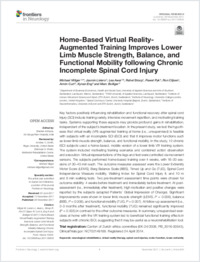Home-Based Virtual Reality-Augmented Training Improves Lower Limb Muscle Strength, Balance, and Functional Mobility following Chronic Incomplete Spinal Cord Injury.
- Villiger M Department of Business Economics, Health and Social Care, University of Applied Sciences and Arts of Southern Switzerland, Landquart, Manno, Switzerland.
- Liviero J Institute of Human Movement Science and Sport, ETH Zurich, Zurich, Switzerland.
- Awai L Institute of Neurology, University College London, London, United Kingdom.
- Stoop R Department of Business Economics, Health and Social Care, University of Applied Sciences and Arts of Southern Switzerland, Landquart, Manno, Switzerland.
- Pyk P Institute of Neuroinformatics, University of Zurich and ETH Zurich, Zurich, Switzerland.
- Clijsen R Department of Business Economics, Health and Social Care, University of Applied Sciences and Arts of Southern Switzerland, Landquart, Manno, Switzerland.
- Curt A Spinal Cord Injury Center, University Hospital Balgrist, Zurich, Switzerland.
- Eng K Institute of Neuroinformatics, University of Zurich and ETH Zurich, Zurich, Switzerland.
- Bolliger M Spinal Cord Injury Center, University Hospital Balgrist, Zurich, Switzerland.
- 2017-12-14
Published in:
- Frontiers in neurology. - 2017
lower extremity
motor function
neurological rehabilitation
spinal cord injuries
virtual reality therapy
English
Key factors positively influencing rehabilitation and functional recovery after spinal cord injury (SCI) include training variety, intensive movement repetition, and motivating training tasks. Systems supporting these aspects may provide profound gains in rehabilitation, independent of the subject's treatment location. In the present study, we test the hypotheses that virtual reality (VR)-augmented training at home (i.e., unsupervised) is feasible with subjects with an incomplete SCI (iSCI) and that it improves motor functions such as lower limb muscle strength, balance, and functional mobility. In the study, 12 chronic iSCI subjects used a home-based, mobile version of a lower limb VR training system. The system included motivating training scenarios and combined action observation and execution. Virtual representations of the legs and feet were controlled via movement sensors. The subjects performed home-based training over 4 weeks, with 16-20 sessions of 30-45 min each. The outcome measures assessed were the Lower Extremity Motor Score (LEMS), Berg Balance Scale (BBS), Timed Up and Go (TUG), Spinal Cord Independence Measure mobility, Walking Index for Spinal Cord Injury II, and 10 m and 6 min walking tests. Two pre-treatment assessment time points were chosen for outcome stability: 4 weeks before treatment and immediately before treatment. At post-assessment (i.e., immediately after treatment), high motivation and positive changes were reported by the subjects (adapted Patients' Global Impression of Change). Significant improvements were shown in lower limb muscle strength (LEMS, P = 0.008), balance (BBS, P = 0.008), and functional mobility (TUG, P = 0.007). At follow-up assessment (i.e., 2-3 months after treatment), functional mobility (TUG) remained significantly improved (P = 0.005) in contrast to the other outcome measures. In summary, unsupervised exercises at home with the VR training system led to beneficial functional training effects in subjects with chronic iSCI, suggesting that it may be useful as a neurorehabilitation tool.
Trial registration
Canton of Zurich ethics committee (EK-24/2009, PB_2016-00545), ClinicalTrials.gov: NCT02149186. Registered 24 April 2014.
Trial registration
Canton of Zurich ethics committee (EK-24/2009, PB_2016-00545), ClinicalTrials.gov: NCT02149186. Registered 24 April 2014.
- Language
-
- English
- Open access status
- gold
- Identifiers
-
- DOI 10.3389/fneur.2017.00635
- PMID 29234302
- Persistent URL
- https://fredi.hepvs.ch/global/documents/265659
Statistics
Document views: 11
File downloads:
- fulltext.pdf: 0
